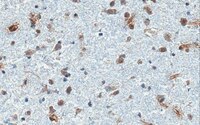Secreted protein acidic and rich in cysteine (SPARC) inhibits integrin-mediated adhesion and growth factor-dependent survival signaling in ovarian cancer.
Said, N; Najwer, I; Motamed, K
The American journal of pathology
170
1054-63
2007
Show Abstract
The matricellular glycoprotein SPARC (secreted protein acidic and rich in cysteine) has been accorded major roles in regulation of cell adhesion and proliferation, as well as tumorigenesis and metastasis. We have recently reported that in addition to its potent antiproliferative and proapoptotic functions, SPARC also abrogates ovarian carcinoma cell adhesion, a key step in peritoneal implantation. However, the underlying molecular mechanism through which SPARC ameliorates peritoneal ovarian carcinomatosis seems to be multifaceted and has yet to be delineated. Herein, we show that SPARC significantly inhibited integrin-mediated ovarian cancer cell adhesion to extracellular matrix proteins, as well as to peritoneal mesothelial cells. This counteradhesive effect of SPARC was shown to be mediated in part through significant attenuation of cell surface expression and clustering of alpha(v)-integrin subunit, alpha(v)beta(3)- and alpha(v)beta(5)-heterodimers, and beta(1)-subunit, albeit to a lesser extent, in ovarian cancer cells. Moreover, SPARC significantly suppressed both anchorage-dependent and -independent activation of AKT and mitogen-acti-vated protein kinase survival signaling pathways in ovarian cancer cells in response to serum and epidermal growth factor stimulation. In summary, we have identified a novel role of SPARC as a negative regulator of both integrin-mediated adhesion and growth factor-stimulated survival signaling pathways in ovarian cancer. | 17322388
 |
Unique ability of integrin alpha(v)beta 3 to support tumor cell arrest under dynamic flow conditions.
Pilch, J; Habermann, R; Felding-Habermann, B
The Journal of biological chemistry
277
21930-8
2002
Show Abstract
Shear-resistant arrest of circulating tumor cells is required for metastasis from the blood stream. Arrest during blood flow can be supported by tumor cell interaction with attached, activated platelets. This is mediated by tumor cell integrin alpha(v)beta3 and cross-linking plasma protein ligands. To analyze the mechanism of tumor cell ligand interactions under dynamic flow conditions, we used real-time video microscopy and tested human melanoma cell binding to fibrinogen, von Willebrand Factor, or fibronectin matrices in a buffer perfusion system. When perfused at venous flow, melanoma cells arrested abruptly and began to spread immediately. This was uniquely mediated by integrin alpha(v)beta3 on all tested ligands, and required alpha(v)beta3 activation and actin polymerization. Under static conditions, alpha(v)beta3 cooperated with alpha(v)beta1 and alpha5beta1 in supporting melanoma cell adhesion to fibronectin. But even when activated, beta1 integrins did not contribute to melanoma cell arrest during flow. Soluble ligand served as a cross-linker between attached and circulating tumor cells and enhanced melanoma cell arrest. Cohesion of activated melanoma cells was restricted to the matrix surface and did not occur in suspension. We conclude that the presence of alpha(v)beta3 in a functionally activated state provides a unique advantage for circulating tumor cells by promoting tumor cell arrest in the presence of flow-dependent shear forces. | 11934894
 |
Integrin activation controls metastasis in human breast cancer.
Felding-Habermann, B; O'Toole, TE; Smith, JW; Fransvea, E; Ruggeri, ZM; Ginsberg, MH; Hughes, PE; Pampori, N; Shattil, SJ; Saven, A; Mueller, BM
Proceedings of the National Academy of Sciences of the United States of America
98
1853-8
2001
Show Abstract
Metastasis is the primary cause of death in human breast cancer. Metastasis to bone, lungs, liver, and brain involves dissemination of breast cancer cells via the bloodstream and requires adhesion within the vasculature. Blood cell adhesion within the vasculature depends on integrins, a family of transmembrane adhesion receptors, and is regulated by integrin activation. Here we show that integrin alpha v beta 3 supports breast cancer cell attachment under blood flow conditions in an activation-dependent manner. Integrin alpha v beta 3 was found in two distinct functional states in human breast cancer cells. The activated, but not the nonactivated, state supported tumor cell arrest during blood flow through interaction with platelets. Importantly, activated alpha v beta 3 was expressed by freshly isolated metastatic human breast cancer cells and variants of the MDA-MB 435 human breast cancer cell line, derived from mammary fat pad tumors or distant metastases in severe combined immunodeficient mice. Expression of constitutively activated mutant alpha v beta 3(D723R), but not alpha v beta 3(WT), in MDA-MB 435 cells strongly promoted metastasis in the mouse model. Thus breast cancer cells can exhibit a platelet-interactive and metastatic phenotype that is controlled by the activation of integrin alpha v beta 3. Consequently, alterations within tumors that lead to the aberrant control of integrin activation are expected to adversely affect the course of human breast cancer. | 11172040
 |
A beta 3 integrin mutation abolishes ligand binding and alters divalent cation-dependent conformation.
Loftus, JC; O'Toole, TE; Plow, EF; Glass, A; Frelinger, AL; Ginsberg, MH
Science (New York, N.Y.)
249
915-8
1990
Show Abstract
The ligand-binding function of integrin adhesion receptors depends on divalent cations. A mutant alpha IIb beta 3 integrin (platelet gpIIb/IIIa) that lacks ligand recognition shows immunologic evidence of a perturbed interaction with divalent cations. This was found to be caused by a G----T mutation that resulted in an Asp119----Tyr119 substitution in the beta 3 subunit. This residue is proximal to bound ligand and is in a conserved region among integrins that are enriched in oxygenated residues. The spacing of these residues aligns with the calcium-binding residues in EF hand proteins, suggesting interaction with receptor-bound divalent cation as a mechanism of ligand binding common to all integrins. | 2392682
 |











